拟南芥转基因
拟南芥的遗传研究和基因突变

探究拟南芥在不同生长发育阶段和逆境条件下的代谢物变化规律, 揭示其代谢调控机制。
推动转化医学和精准农业发展
要点一
转化医学研究
利用拟南芥作为模式生物,研究人类 疾病的发病机制和药物作用靶点,为 转化医学提供理论支持。
要点二
精准农业应用
将拟南芥遗传研究成果应用于作物育 种和农业生产中,通过基因编辑、分 子标记辅助选择等技术手段,实现作 物精准育种和高效生产。同时,利用 拟南芥作为生物指示器,监测和评估 农业生态环境的健康状况。
拟南芥的遗传研究和基因
突变
汇报人:XX
2024-01-11
• 拟南芥概述 • 遗传研究方法与技术 • 基因突变类型与机制 • 拟南芥基因突变研究实例 • 遗传研究在农业领域应用 • 未来展望与挑战
01
拟南芥概述
生物学特性
形态特征
拟南芥是一种小型、多年生草本植物,具有典型的莲座叶丛和直立茎。其叶片呈长椭圆形,花朵为四瓣白色或淡紫色 ,果实为长角果。
且排水良好的环境中。
02Leabharlann 分布范围由于其适应性强,拟南芥现已广泛分布于全球各地,包括北美、南美、
非洲和大洋洲等地区。
03
生长条件
拟南芥对生长条件的要求并不严格,可以在多种土壤类型和温度条件下
生长。然而,为了获得最佳的生长效果,需要提供充足的光照和适中的
水分。
遗传背景与重要性
• 基因组特点:拟南芥的基因组相对较小且简单,约包含120Mbp的DNA序列 和大约25000个基因。这使得对其进行全基因组测序和分析相对容易。
研究植物在盐碱胁迫下 的生理生化反应和分子 机制,发掘耐盐碱相关 基因,通过遗传转化提 高作物的耐盐碱能力。
拟南芥植物基因功能研究
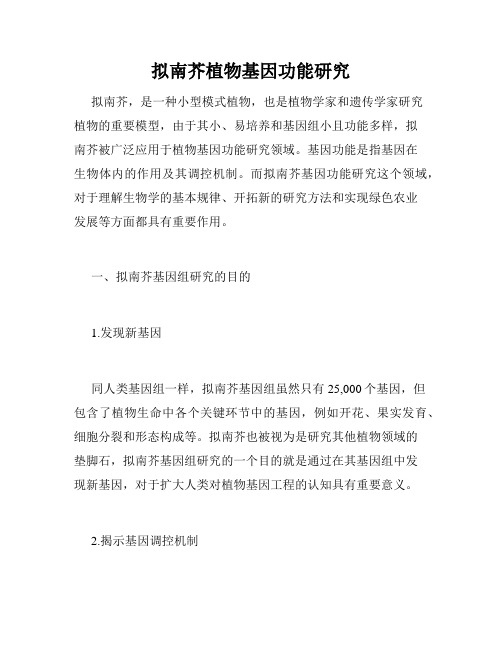
拟南芥植物基因功能研究拟南芥,是一种小型模式植物,也是植物学家和遗传学家研究植物的重要模型,由于其小、易培养和基因组小且功能多样,拟南芥被广泛应用于植物基因功能研究领域。
基因功能是指基因在生物体内的作用及其调控机制。
而拟南芥基因功能研究这个领域,对于理解生物学的基本规律、开拓新的研究方法和实现绿色农业发展等方面都具有重要作用。
一、拟南芥基因组研究的目的1.发现新基因同人类基因组一样,拟南芥基因组虽然只有25,000个基因,但包含了植物生命中各个关键环节中的基因,例如开花、果实发育、细胞分裂和形态构成等。
拟南芥也被视为是研究其他植物领域的垫脚石,拟南芥基因组研究的一个目的就是通过在其基因组中发现新基因,对于扩大人类对植物基因工程的认知具有重要意义。
2.揭示基因调控机制在拟南芥中,基因的调控是非常复杂的,包括转录和后转录调控。
这些调节机制的研究,能够让我们更进一步地了解到,不同的基因所在的生物体部分是如何相互作用的,那会使我们有机会研究这些交互可能会导致的不良病状。
3.寻找抗病基因病原体和虫害对植物的危害,一直是植物学家们所担心的一个问题,而找出植物的制药基因,能够从分子基础上开展对植物抵抗病原体的研究,也能够为解决粮食安全问题提供更多的资源。
二、拟南芥基因功能研究方法由于拟南芥基因组具有可塑性和许多实验工具,开展拟南芥的基因功能研究显得异常的简单。
目前,关于拟南芥功能的研究方法,主要包括以下几种:1. 整合遗传和基因组学方法先通过遗传学方法,确定目标基因,再进一步使用基因组学技术确立其在基因组上的位置。
这种方法的优点在于定位准确,可以将与给定特征相关的基因数量缩小到较小的范围。
2.基因敲除技术基因敲除是利用RNA 骨架扰动小分子介导的细胞自身保护机制,通过基因克隆进行敲除,破坏载体、导致细胞死亡的一种方法。
该方法将基因关掉,根据有没有出现问题来了解基因起了哪些作用。
3.遗传页面显微镜遗传页面显微镜用于观察拟南芥基因生成物的进化变化,以及基因功能的变化,为了更好地确定基因的发生方式和发生地点。
拟南芥的遗传转化
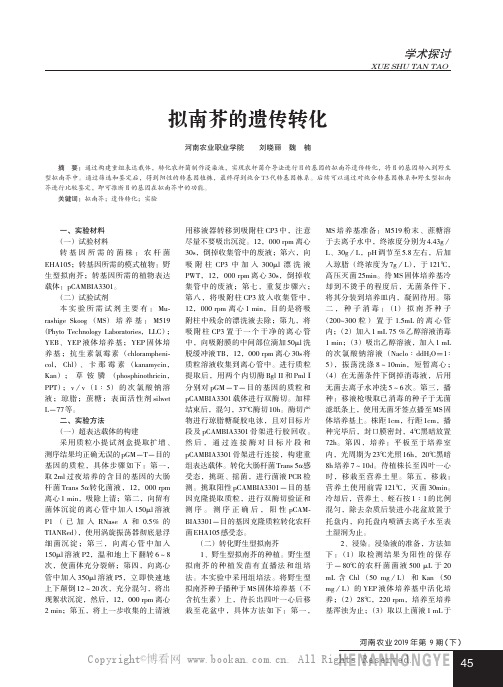
XU E SHU TA N TA O学术探讨拟南芥的遗传转化河南农业职业学院刘晓丽魏楠摘要:通过构建重组表达载体,转化农杆菌制作浸染液,实现农杆菌介导法进行目的基因的拟南芥遗传转化,将目的基因转入到野生型拟南芥中。
通过筛选和鉴定后,得到阳性的转基因植株,最终得到纯合T3代转基因株系。
后续可以通过对纯合转基因株系和野生型拟南芥进行比较鉴定,即可推断目的基因在拟南芥中的功能。
关键词:拟南芥;遗传转化;实验一、实验材料(一)试验材料转基因所需的菌株:农杆菌EHA105;转基因所需的模式植物:野生型拟南芥;转基因所需的植物表达载体:pCAMBIA3301。
(二)试验试剂本实验所需试剂主要有:Mu⁃rashige Skoog(MS)培养基:M519(Phyto Technology Laboratories,LLC);YEB、YEP液体培养基;YEP固体培养基;抗生素氯霉素(chlorampheni⁃col,Chl)、卡那霉素(kanamycin,Kan);草铵膦(phosphinothricin,PPT);v/v(1∶5)的次氯酸钠溶液;琼脂;蔗糖;表面活性剂silwet L-77等。
二、实验方法(一)超表达载体的构建采用质粒小提试剂盒提取扩增、测序结果均正确无误的pGM-T-目的基因的质粒,具体步骤如下:第一,取2ml过夜培养的含目的基因的大肠杆菌Trans5α转化菌液,12,000rpm 离心1min,吸除上清;第二,向留有菌体沉淀的离心管中加入150μl溶液P1(已加入RNase A和0.5%的TIANRed),使用涡旋振荡器彻底悬浮细菌沉淀;第三,向离心管中加入150μl溶液P2,温和地上下翻转6~8次,使菌体充分裂解;第四,向离心管中加入350μl溶液P5,立即快速地上下颠倒12~20次,充分混匀,将出现絮状沉淀,然后,12,000rpm离心2min;第五,将上一步收集的上清液用移液器转移到吸附柱CP3中,注意尽量不要吸出沉淀。
6、GFP转基因拟南芥的筛选及荧光观察

卡那培养基上筛选tubulin-GFP转基因幼苗
生长一个月左右的GFP转基因植株
体式荧光显微镜观察GFP转基因植株
Bars= 100 μm
CONFOCAL荧光显微镜观察GFP-TUBULIN 在气孔保卫细胞中的定位
材料与试剂
• 材料:野生型拟南芥种子WT、 GFP转基因拟南芥种子
• 试剂:
75%乙醇; 50%84消毒液; 无菌水; MS培养基;
。 MS+kan(卡那霉素)培养基 1ml 移液器
实验操作注意事项: • 严格无菌操作! • 消毒过程动作要快! • 枪头不要重复使用,物品不要拿出超净 台! • 点种时每个位置尽量只点一颗种子! • 操作时尽量避免说话和人员走动! • 注意小组内的配合和小组间的协调!
种子消毒及播种实验流程 (超净工作台中完成所有步骤)
1. 将培ห้องสมุดไป่ตู้皿做好标记, 2. WT和GFP两种类型的种子已春化( 置于4℃冰箱48h)(已
做); 3. 用1 ml量程的移液器去掉EP管中的ddH2O,加入新的500 ul
ddH2O ,再加入500ul 84消毒液,混匀;颠倒数次,孵育6 min (混匀,尽量将液体吸净,动作要快); 4. 1 ml无菌ddH2O水,洗3遍后,去上清 5. 最后加入200 μl ddH2O 6. 用移液器吸取单颗种子,将种子点在培养基表面(每皿4-5 颗种子 尽量均匀); 7. 封膜,正置平放于培养架上培养。
实验六、八
GFP转基因拟南芥的筛选及荧光观察
2019-11-13
实验六 拟南芥种子消毒及无菌培养
实验目的
1.建立无菌实验操作的概念; 2.掌握植物(拟南芥)无菌培养的方法。
GFP报告基因
转基因拟南芥步骤

转基因拟南芥步骤
转基因拟南芥啊,这可是个挺有意思的事儿呢!咱就一步步来瞧瞧。
首先呢,你得有拟南芥,这就好比做饭得有食材呀。
得挑那些长得
健康、精神的拟南芥植株。
然后呢,你得想好要转进去啥基因,这就
跟你决定给菜加啥调料一样重要。
接下来就是关键步骤啦!得把你想要的基因给弄出来,这可不是随
随便便就能做到的哦。
就好像从一堆宝贝里精准地挑出你最想要的那
一个。
挑出来基因后,还得找个合适的载体,让这个基因能跟着载体一起
进入拟南芥里。
这载体就像是一辆小车子,载着基因去它该去的地方。
然后呢,就是把带着基因的载体和拟南芥凑到一块儿啦。
这可不是
简单地放一起就行,得用一些特别的方法,就好像要把钥匙插进锁孔里,得找对角度和力度。
等基因进去了,还得让拟南芥好好长一长,看看基因是不是真的转
进去了。
这就跟等菜做好了,尝尝味道对不对一样。
哎呀,你说这过程是不是挺复杂的?但这也是科学的魅力所在呀!
每一步都得小心翼翼,就跟走钢丝似的。
要是有一步出了错,那可能
就前功尽弃啦。
你想想,要是能成功地把想要的基因转到拟南芥里,那多有成就感啊!就好像你自己创造了一个小小的奇迹。
而且这转基因拟南芥用处可大啦!可以帮助我们研究基因的功能,可以让我们更好地了解植物的生长发育,还能为农业生产带来新的希望呢!
总之呢,转基因拟南芥虽然步骤多,过程复杂,但只要你有耐心,有细心,就一定能做好。
你说是不是呢?可别小瞧了这小小的拟南芥哦,它里面蕴含着大大的科学奥秘呢!。
拟南芥遗传转化实验报告
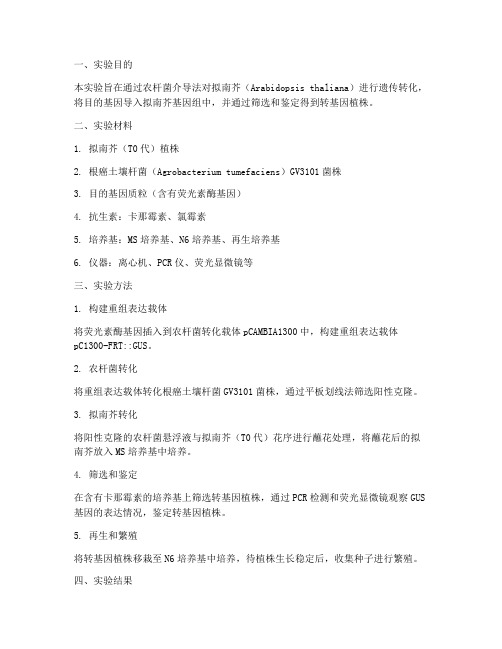
一、实验目的本实验旨在通过农杆菌介导法对拟南芥(Arabidopsis thaliana)进行遗传转化,将目的基因导入拟南芥基因组中,并通过筛选和鉴定得到转基因植株。
二、实验材料1. 拟南芥(T0代)植株2. 根癌土壤杆菌(Agrobacterium tumefaciens)GV3101菌株3. 目的基因质粒(含有荧光素酶基因)4. 抗生素:卡那霉素、氯霉素5. 培养基:MS培养基、N6培养基、再生培养基6. 仪器:离心机、PCR仪、荧光显微镜等三、实验方法1. 构建重组表达载体将荧光素酶基因插入到农杆菌转化载体pCAMBIA1300中,构建重组表达载体pC1300-FRT::GUS。
2. 农杆菌转化将重组表达载体转化根癌土壤杆菌GV3101菌株,通过平板划线法筛选阳性克隆。
3. 拟南芥转化将阳性克隆的农杆菌悬浮液与拟南芥(T0代)花序进行蘸花处理,将蘸花后的拟南芥放入MS培养基中培养。
4. 筛选和鉴定在含有卡那霉素的培养基上筛选转基因植株,通过PCR检测和荧光显微镜观察GUS 基因的表达情况,鉴定转基因植株。
5. 再生和繁殖将转基因植株移栽至N6培养基中培养,待植株生长稳定后,收集种子进行繁殖。
四、实验结果1. 构建重组表达载体成功构建了含有荧光素酶基因的重组表达载体pC1300-FRT::GUS。
2. 农杆菌转化通过平板划线法筛选到阳性克隆,表明重组表达载体已成功转化根癌土壤杆菌GV3101菌株。
3. 拟南芥转化蘸花处理后,部分拟南芥植株在含有卡那霉素的培养基上生长,表明转基因植株已成功筛选。
4. 筛选和鉴定通过PCR检测和荧光显微镜观察,发现部分转基因植株GUS基因表达阳性,荧光素酶活性明显。
5. 再生和繁殖将转基因植株移栽至N6培养基中培养,植株生长良好,繁殖成功。
五、实验讨论1. 本实验通过农杆菌介导法成功将荧光素酶基因导入拟南芥基因组中,获得了转基因植株。
2. 在实验过程中,农杆菌转化和拟南芥转化效果良好,表明该实验方法适用于拟南芥遗传转化。
实验三(1)通过根瘤农杆菌转化拟南芥

4.将沉淀用200ml浸染液重悬,形成均匀的农杆菌悬浮液 (OD600=0.8左右),并将农杆菌悬浮液转移到一个敞口 的器皿中(500ml烧杯)。 5.选取初果期的健壮植株,带盆钵一起倒扣于盛有农杆菌悬 浮液的容器上方,将整个花序浸入上述农杆菌悬浮液中约 20-30秒,注意叶片尽量不与浸染液接触。同一个烧杯中 的农杆菌悬浮液可以转化10株或者更多株拟南芥。在此过 程中,尽量避免将蛭石倒入农杆菌悬浮液中。 6.将盆钵取下,横放于暗箱中约24小时。注意保持一定的 湿度。 7.24小时后将处理过的拟南芥植株放于22~25℃的光照条 件下使其正常生长。 8.大约三周后收取成熟种子。
人工改造后的Ti质粒
1.保留T-DNA的转移功能,去掉T-DNA的致瘤性, 有利于转化体再生植株; 2.在T-DNA左右边界序列之间构建一段DNA序列, 其上含有一系列单个的限制性内切酶的识别位点、 即单克隆位点,以利于插入外源DNA和其后的操 作; 3.具有目的基因表达所需的启动子、终止子以及提 供重组细胞筛选的标记基因等; 4.具有使质粒能够在大肠杆菌中进行复制的DNA复 制起始位点,某些载体还同时带有可在农杆菌中 进行复制的起始位点。
思 考 题
1.目前拟南芥稳定表达有几种基本的方法? 试分析不同转化方法的优缺点。 2.植物转基因技术有哪些应用? 3.拟南芥作为研究植物发育的重要模式植株 之一,请问有哪些特性?
培养基配制
准备—下周筛转基因种子和萌发实验。每两个人一 组,准备下述平板: (1)1个含有卡那霉素(50 mg/L)的 1/2 MS固体 平板; (2)1个1/2 MS固体平板(不含任何抗生素或者是 激素); (3)一个加200 mM NaCl 1/2 MS固体平板(不含 抗生素); (4)一个加1µM ABA 2 MS固体。 灭菌后将平板倒好并再4 ℃保存备用。
MTI2和Bt转基因拟南芥的鉴定及筛选

内蒙古农业大学硕士学位论文MTI2和Bt转基因拟南芥的鉴定及筛选姓名:王晓娟申请学位级别:硕士专业:作物遗传育种指导教师:于卓;杨丽梅2007050118MTl2和Bt转基因拟南芥的鉴定及筛选试验设定了7个卡那霉素浓度梯度,分别为:50、100、200、300、400、5001119/L。
由表l可见,卡那霉素对试验材料的发芽率没有显著影响,而对幼苗白化率有显著影响,随着浓度的增大,幼苗白化率逐渐增高。
说明卡那霉素不影响种子萌发却能抑制芽的生长。
当浓度达到300mg/L时,未转化基因的野生型拟楠芥种子3个处理全部白化,无一株成活的绿茁,而转基因Tl代种子仍有部分幼苗正常生长。
本试验采用的卡那霉素筛选浓度定为300mg/L。
图2卡那霉素浓度从左至右分别为50、200,300mg/L时对照Colombia筛选20d的表现Fig.2Theresultofnon·transformedArabidopsisthalianaseedsselectedbykanamycin表5a00mg/L卡那霉素对TI代种子筛选结果Table5TheresultofT5generationseedsselectedbykanamycin300mg/L图3卡那霉素浓度300m∥L时Ts代转基因种子和未转化亲本筛选20d时的对比Fig3TheresultofLgenerationsoedsandnon-transformedArabidopsisthalianaseeds∞le,ctedbykanamycin内蒙古农业大学硕士学位论文19将试验中得到的Tl代87株抗性苗编号移栽到苗钵中,在人工气候培养室培养。
待到收获时严格单株收获种子,即T2代种子。
继续用300mg/L的卡那霉素进行筛选,直到抗性不再发生分离时,结束试验。
试验中,在T3代就已经有全部呈现抗性的材料出现,后又对其进行了两代筛选,确保抗性基因达到了纯合。
拟南芥转化
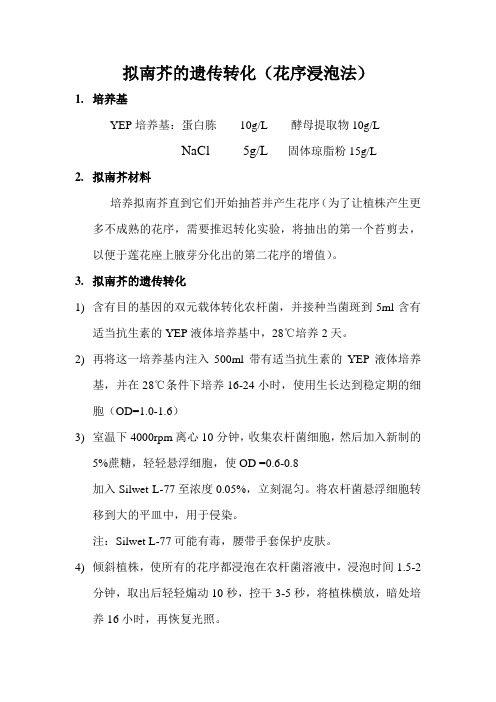
拟南芥的遗传转化(花序浸泡法)
1.培养基
YEP培养基:蛋白胨10g/L 酵母提取物10g/L
NaCl 5g/L 固体琼脂粉15g/L
2.拟南芥材料
培养拟南芥直到它们开始抽苔并产生花序(为了让植株产生更多不成熟的花序,需要推迟转化实验,将抽出的第一个苔剪去,以便于莲花座上腋芽分化出的第二花序的增值)。
3.拟南芥的遗传转化
1)含有目的基因的双元载体转化农杆菌,并接种当菌斑到5ml含有
适当抗生素的YEP液体培养基中,28℃培养2天。
2)再将这一培养基内注入500ml带有适当抗生素的YEP液体培养
基,并在28℃条件下培养16-24小时,使用生长达到稳定期的细胞(OD=1.0-1.6)
3)室温下4000rpm离心10分钟,收集农杆菌细胞,然后加入新制的
5%蔗糖,轻轻悬浮细胞,使OD =0.6-0.8
加入Silwet L-77至浓度0.05%,立刻混匀。
将农杆菌悬浮细胞转移到大的平皿中,用于侵染。
注:Silwet L-77可能有毒,腰带手套保护皮肤。
4)倾斜植株,使所有的花序都浸泡在农杆菌溶液中,浸泡时间1.5-2
分钟,取出后轻轻煽动10秒,控干3-5秒,将植株横放,暗处培养16小时,再恢复光照。
5)为了提高转化效率,可以浸泡植株两次,中间相隔7天。
6)分株收种子,并在含有合适抗生素的MS培养基上萌发,筛选得
到T1转基因拟南芥。
转基因拟南芥培养ppt课件

注意事项: 严格无菌操作! 消毒过程动作要快!
枪头不要重复使用,物品不要拿出超净 台!
点种时每个位置尽量只点一颗种子! 操作时尽量避免说话和人员走动! 注意小组内的配合和小组间的协调!
发现:
绿色荧光蛋白(Green fluorescent protein, GFP)
水母中发现发光蛋白(20世纪60年代)
GFP报告基因
性质: 238氨基酸组成的单链多肽 在蓝光或紫外光激发下发出绿色荧光
有什么用呢?
蛋白质在活细胞中的准确定位及动态变化观 察(分泌蛋白的分选、亚细胞定位)
转 基 因 植 株
GFP
Confocal荧光显微镜观察GFP-tubulin 在气孔保卫细胞中种子及幼苗
试剂:MS培养基(wild type) ;
MS卡那抗性培养基(GFP-MAP65); 75%乙醇; 10%NaClO;
无菌水。
种子消毒及播种实验流程
目的基因
目的基因tubulin 拟南芥叶片表皮细胞、保卫细胞中微管骨
架的分布情况 根部细胞
目的基因与载体简介
pGMAP65-1::GFP植物表达载 导入成功? 体的构建
导入农杆菌自我复制
KAN 1
浸染花粉转入拟南芥
pG MA P 65-1-G FP 8658bp
NOS GFP
Ec oRV
PstI StuI
MAP65-1
tubulin
转染成功?
35Sprom otor
Bam HI H3
XbaI
如何判定载体转化成功,植株内是否有目 的基因的表达?
——载体及植株的筛选
生 长 一 个 月 左 右 的
转 基 因 植 株
从拟南芥的T0123代获得纯合株系转基因必经之路

从拟南芥的T0123代获得纯合株系转基因必经之路作为模式生物,拟南芥(Arabidopsis thaliana)主要有以下几方面的优势:第一,拟南芥的基因组在常见的植物模型中是最小的,染色体数目也很少,只有五对同源染色体。
第二,植株体积小,对环境的适应性强,生活周期短,繁殖能力强,播种到收种需要两个月左右。
第三,自然条件下,拟南芥是严格的闭花自花传粉,基因高度纯合,易稳定遗传,强可诱变性。
第四,拟南芥研究的相关遗传手段和生化分子技术都已经比较成熟。
第五,丰富的种质资源。
运用高通量转化技术得到的T-DNA插入的突变体库,已经鉴定的独立的T-DNA插入株,几乎覆盖了所有的编码基因。
健康生长的时候还是蛮可爱的获得转基因拟南芥T0代:日常使用浸花法(floral dip method)(Clough等,1998)转化拟南芥。
将拟南芥的花序放到含有农杆菌的转化介质中浸泡3~5分钟,在转化介质的帮助下,农杆菌可以穿过植物细胞壁和质膜,侵染雌配子体即胚囊,并将带有目的基因和元件的T-DNA片段整合到雌配子的基因组上(Desfeux等,2000; Bent A, 2023)。
T1T2T3获得纯合株系:1.野生型拟南芥,称为T0代,经过侵染之后,而从T0代上收集到的种子是T1代种子(混合收种)2.将T1代种子铺种在含有抗生素的MS培养基上,直接筛选出转基因T1代阳性的幼苗,移栽到穴盘,悉心呵护,收集到T2代种子(单株收种)。
需要注意的是,T1代均为杂合子,但是并不确定是单拷贝或是多拷贝插入。
3.将T2代种子铺种在含有抗生素的MS培养基上,此时阳性苗:阴性苗(未发芽的种子不计入)如果符合3:1的分离比,则目的基因以单拷贝插入,将其中的阳性苗移栽,同样悉心呵护,收集T3代种子(单株收种)。
不符合3:1则可能有多个拷贝插入不同位点(多拷贝插入往往会引起基因沉默现象,扔了算了)。
4.将T3代种子铺种在含有抗生素的MS培养基上,一段时间之后,你发现一些培养皿里全是阳性苗,恭喜!你拿到了自己的转基因纯合株系。
拟南芥转基因

GENETIC TRANSFORMATION AND HYBRIDIZATIONTransformation by T-DNA integration causes highly sterile phenotype independent of transgenes in Arabidopsis thalianaXiaochun Ge ÆHai Wang ÆKaiming CaoReceived:23March 2008/Revised:4May 2008/Accepted:18May 2008/Published online:3June 2008ÓSpringer-Verlag 2008Abstract Agrobacterium tumefaciens-mediated gene transformation caused highly sterile phenotype in T1transgenic populations of Arabidopsis thaliana .The phe-nomenon occurred independent of the genes and construct types used for transformation.The occurring frequency is less than 10%and the phenotype is inheritable.Intensive examination elucidated that the sterility is due to indehis-cence or delayed dehiscence of the anthers during the flowering stage,resulting from the reduced or disordered endothecial secondary wall thickening of the anthers in the sterile flowers.Exogenous jasmonic acid application can-not rescue the sterile phenotype.Additionally,by using the Escherichia coli uidA gene encoding the b -glucuronidase as a reporter gene,we indicated that the Cauliflower mosaic virus 35S promoter was not constitutively active as expected previously in the reproductive organs of Arabid-opsis .These results contribute significantly to the plant community by suggesting that more careful examination and statistical analysis are needed while studying gain-of-function phenotypes of genes,especially for genes that might be involved in reproductive development.Keywords Arabidopsis thaliana ÁCauliflower mosaic virus 35S promoter ÁGene transformation ÁSterilityAbbreviationsCaMV-35S Cauliflower mosaic virus (CaMV)35SpromoterGUS b -GlucuronidaseTAIL-PCR Thermal asymmetric interlaced polymerasechain reactionGFP Green fluorescence protein PBS Phosphate-buffered saline X-GLUC 5-Bromo-4-chloro-3-indolyl-b -D -glucuronideIntroductionTransgenic technique is commonly used for studying gene function and genetically modifying important economical plant species.Introduction of exogenous genes into plants is usually carried out by Agrobacterium tumefaciens ,which transfers and integrates a portion of the tumor-inducing (Ti)plasmid into plant nuclear genome while infecting host plants (Azpironz-Leehan and Feldmann 1997;Sessions et al.2002).The transferred portion,called T-DNA,orig-inally necessary for inducing gall formation in the host plants,can be genetically modified to fulfill the goal of transforming exogenous genes into host plants (Krysan et al.1999;Tax and Vernon 2001).Numerous plant transformation vectors have been constructed by replacing the dispensable region of T-DNA with the desired DNA fragment by various researchers.Two short regions at the ends of the T-DNA,called the left border (LB)and right border (RB),are necessary for the T-DNA transfer and subsequent integration (Gheysen et al.1991).Although the molecular mechanisms for T-DNA integration are not well understood,T-DNA appears to randomly insert itself within the genome (Qin et al.2003).Communicated by J.R.Liu.X.Ge (&)ÁH.Wang ÁK.CaoState Key Laboratory of Genetic Engineering,Institute of Plant Biology,Department of Biochemistry and Molecular Biology,School of Life Sciences,220Handan Road,Shanghai 200433,People’s Republic of Chinae-mail:xcge@;gexiaochun1@Plant Cell Rep (2008)27:1341–1348DOI 10.1007/s00299-008-0561-6A variety of transformation vectors based on T-DNA have been used to generate transgenic plants.In various transformation vectors,the cauliflower mosaic virus (CaMV)35S promoter(CaMV-35S promoter)is widely used for overexpressing an exogenous gene in plants to study the gain-of-function phenotype or to genetically improve crop agronomical features.During many gene transformation experiments using CaMV-35S promoter for driving ectopic overexpression,we repeatedly noticed that there are very few highly sterile plants in the T1transgenic populations.They have similar phenotype as other fertile transgenic plants during vegetative growth stage,but most of theflowers are sterile at the reproductive growth stage. Furthermore,the highly sterile phenotype is genetically inheritable,indicating that it is not caused by environ-mental stresses such as antibiotic screening on the plates. Since plants showing this kind of phenotype are few,this phenomenon is easily ignored.To understand what caused this phenotype,we investigated this phenomenon in more depth,and discussed its implication for studying the gene function of Arabidopsi s through phenotypic analysis of transgenic plants.In addition,CaMV-35S promoter is usually considered to be ubiquitously active in all plant tissues and organs (Schnurr and Guerra2000).In this work,we also inves-tigated the activity of CaMV-35S promoter in A rabidopsis reproductive organs and indicated that CaMV-35S promoter has temporal and spatial specificity in these organs.Materials and methodsPlant materials and the Agrobacterium strainArabidopsis thaliana ecotype Columbia was used in this study.The plants were grown at22°C under long-day conditions(16h light/8h dark,150l mol m-2s-1). Agrobacterium tumefaciens strain C58C01and plant transformation vector p35S::GUS,p35S::GFP,p35S::Fast, pBI101.3and pCHF3were used for transgenic experiments.Arabidopsis transformationTransformation of Arabidopsis by Agrobacterium tum-efaciens C58C01was performed byfloral dipping as described by Clough and Bent(1998).b-Glucuronidase stainingMaterials were washed twice with cold staining solution without X-GLUC[2mM K3Fe(CN)6,2mM K4Fe(CN)6,0.1%Triton X-100in0.1M sodium phosphate buffer]and then put into staining buffer with0.1%X-GLUC(0919, Amresco)and vacuumed for infiltration for10min.The tissues were stained at37°C overnight.Hundred percent ethanol and then70%ethanol were used for destaining.Flowerfixation,dissectioning and microscopyThe tissues werefixed with4%paraformaldehyde over-night at4°C,then dehydrated through an water–ethanol series and embedded in JB4polymer based on the manual provided by the manufacturer(Polysciences,Inc.,War-rington,USA).Sections of2l m were cut by Ultra thin microtome(RMC,powertome-XL,USA).The sections were stained by0.5%toluidine blue in PBS buffer.Pho-tographing was performed under a transmission microscope.Someflower materials were also embedded in wax and dissected into8l m sections for toluidine blue staining.Observation of the lignified secondary wall thickeningSections were stained by a drop of0.1%(w/v)calcofluor white(Polysciences,Inc.,Warrington,USA)for10min and then rinsed thoroughly with distilled water.Observa-tion and photography was carried out using a Nikon C1-Eclipse800Confocal microscope(Nikon,Japan)under UV light excitation.For lactic acid clearing,anthers from the wild type and transgenic plants were dissected and cleared in70%(v/v)lactic acid at60°C for3days based on the method described by Dawson et al.(1999).Cleared tissues were examined and photographed under a transmission microscope.Characterization of T-DNAflanking sequencesThe T-DNA insertionflanking sequence was isolated and sequenced by thermal asymmetric interlaced polymerase chain reaction(TAIL-PCR)based on the method described by Liu et al.(1993,1995).Results and discussionThe highly sterile phenotype occurred in the T1 transgenic populationWe have used p35S::GFP,pCHF3,p35S::Fast vectors for foreign gene transformation.These vectors have different origins but35S-CaMV promoter is commonly used.We consistently observed that there were about1.7–10%plants that were highly sterile in the T1transgenic populations (Fig.1a–d).However,the transgenes carried in thesevectors are different,including genes encoding carbonic anhydrase,lipid transfer protein,nudix family proteins,similar to rcd-one (SRO)family proteins,etc.(Table 1).Overexpression of these genes does not cause any visible phenotype under normal growth conditions,and the functions of these transgenes have not been described to be related to the reproductive development.Except during the flowering stage most of the flowers were sterile,the T1highly sterile plants appeared indistinguishable from other transgenic plants during the vegetative growth stage.ToFig.1Phenotype of the highly sterile T1transgenic plants.a ,c The highly sterile plantsoccurred in the T1transgenic populations transformed by a gene encoding lipid transfer protein and a gene encoding nudix protein,respectively;b ,d The branches from the fertile plants and from the highly sterile transgenic plants;e ,f Comparison of the fertile flowers and the highly sterile flowers from the transgenic plants (e stage 11,f stage 13).Part of tissues was removed for easier observation.The released pollens were indicated by an arrow .WT wild type,TStransgenic sterile plants.Bars in e and f :0.5mmexclude the possible effects caused by the sequence of the exogenous genes,we used the empty vectors p35S::GFP, pCHF3and p35S::Fast,which carry different antibiotic genes and different fusion tags for transformation into Arabidopsis.Again,we observed the similar phenomenon. Very few seeds could be harvested from these plants.The T2and T3generations carrying the transgene were also highly sterile,indicating that the phenotype is inheritable and not caused by the environmental stresses.Western blot analysis showed that the transgenes in these highly sterile plants were moderately or strongly expressed,but other plants with the same or even higher expression levels of the corresponding transgenes were normal,indicating that overexpression of the exogenous genes does not neces-sarily lead to this phenotype(Fig.2).Hence,most likely, the sterile phenotype was contributed by T-DNA integration.The indehiscent anthers had reduced endothecial secondary wall thickeningsTo investigate what caused the phenotype,we examined theflowers under microscope.Findings showed that the anthers were closed at stage13(Sanders et al.1999), whereas the corresponding wild type anthers started to release pollen(Fig.1f).No obvious morphological dis-crepancies were observed before that stage(Fig.1e).To look more closely what happened during the anther development,we observed the anthers from the highly sterile transgenic plants as well as the ones from the wild type plants byflower embedding,dissectioning and then microscopy.The anthers of the wild type plants dehisced normally at stage13and then the opened anthers degen-erated gradually during later stages because of senescence (Fig.3a–c).In contrast,most anthers from the highly sterile plants did not dehisce at stage13and they remained closed until falling off theflowers,when the connective cells and the endothecium cells all degenerated(Fig.3d–f). Occasionally,few anthers dehisced at a later stage (Fig.3g),thus set very few siliques.The pollen grains within the indehisced anthers of the sterile plants were morphologically normal and could pollinate the emascu-latedflowers of the wild type plants(data not shown).In addition,the ovules of the sterileflowers could also be fertilized normally by the pollen grains of the fertile plants (data not shown).These evidences indicated that the highly sterile phenotype was not caused by the defects of the male and female gametophytes.Rather,T-DNA transformation may cause the sterile phenotype by blocking or delaying the anther dehiscence.Observation by successive dissectioning revealed no morphological difference before stage10between inde-hisced and wild type anthers.After that stage,the endothecial secondary wall thickenings of the anthers from sterileflowers appeared abnormal(Fig.3a,d).To visually observe the wall thickenings,we used calcofluor white, which can interact with1,4-b-glucans and produce white fluorescence under UV light to highlight the cell wall thickenings.At late stage12,the wild type endothecial wall showed strongfluorescence and had a regular and ordered fibrous band appearance.However,in the indehisced anthers,though some of the endothecial cells underwent partial secondary wall thickenings,the accumulation of the thickening materials was irregular and the organization appeared disordered(Fig.4a,b).In addition,the total thickenings were also reduced compared with those of the wild type.To observe the anther wall structure,lactic acid was used to clear the anthers.Under microscope,the wild type anther wall exhibited a regular network structure.InTable1Statistical analysis of the T1transgenic plants with highly sterile phenotype Vectors Promoter/genes The highly sterileplants/total transgenic plantsRatio(%)p35S::Fast35S/Fast tag5/717p35S::CA-Fast35S/carbonic anhydrase4/70 5.7p35S::LTP144-Fast35S/lipid transfer protein5/687.4p35S::SRO1-Fast35S/similar to rcd1family gene3/55 5.5p35S::SRO2-Fast35S/similar to rcd1family gene6/6010p35S::SRO3-Fast35S/similar to rcd1family gene1/59 1.7p35S::GFP35S/greenfluorescence protein5/707.1p35S::GUS35S/b-glucuronidase3/515.9 Fig.2Western blotting showing that the transformed gene driven byCaMV35S promoter was expressed at different levels in theflowersof T1transgenic lines.Among20transgenic lines,only one of them(lane6)showed highly sterile phenotype.Others are ne14is negative control from wild typeflowers.The samples were blottedusing antiflag antibody,which is against theflag tag fused with thetransformed geneFig.3Dissectioning of the anthers from the wild type and the highly sterile plants.a –c Wild type anthers.The secondary cell wall thickening of endothecium at stage 12is obvious (a );the stomium is opened at stage 13(b );the opened anthers degenerate gradually at stage 14(c ).d –g Anthers of the sterile flowers from the transgenic plants.The endothecial secondary cell wall thickening is abnormal(d );the stomium is closed at stage 14and the pollen grains are not released (e );the connective cell layer and endothecial cell layer degenerate completely at late stage 14,but the pollens are still included (f );very few anthers from the highly sterile transgenic plants dehisce occasionally at very late stage (g ).Bars 50lmFig.4Endothecial secondary wall thickenings of anthers from the wild type and the highly sterile transgenic plants.a ,b Calcofluor-stained sections of anthers at stage 13.a Wild type flower,b indehisced flower.The white fluorescent materials indicate the secondary wall thickenings.c ,d Lactic acid cleared anthers showing the secondary thickening network.c Wild type flower,d indehisced flower.Bars 35l mcontrast,the indehisced anther wall looked more trans-parent and the network was not clear.Pollens included in it are visible(Fig.4c,d).Therefore,the anther indehiscence phenotype of the transgenic plants may be due to the reduced or disordered secondary wall thickenings of the endothecial layer of the anthers.The secondary wall thickenings,composed of lignified material and cellulose,mainly occurred around the endo-thecial cells prior to anther dehiscence(Dawson et al. 1999).The differential desiccation-induced shrinkage of the thickened and unthickened regions of the endothecial cell wall will generate the tensile force necessary for the rupture of the stomium,allowing the pollen release (Dawson et al.1999;Yang et al.2007).A few mutants of Arabidopsis,which have reduced or absent endothecial wall thickenings,were found to be indehiscent(Sanders et al.1999;Dawson et al.1999;Mitsuda et al.2005;Yang et al.2007),demonstrating the importance of the wall thickenings of endothecial layer for anther dehiscence. The anther indehiscence phenotype cannot be rescuedby Jasmonic acidJasmonic acid is the hormone known for playing an important role in controlling the timing of anther dehis-cence(Ishiguro et al.2001).A number of mutants defective in jasmonic acid synthesis pathway display defective anther dehiscence,such as dde1(delayed dehiscence1)/ opr3(oxo-phytodienoic acid reductase3)and dad1 (defective in anther dihiscence1)(Xie et al.1998;Sanders et al.2000;Stintzi and Browse2000;Ishiguro et al.2001; Park et al.2002).To investigate whether the jasmonic acid biosynthesis pathway was affected in the transgenic plants, we applied exogenous jasmonic acid to theflower buds twice a day for1week based on the description by Sanders et al.(2000).The sterile phenotype was not rescued by applying exogenous jasmonic acid,suggesting that the anther indehiscence was not caused by the defect of jas-monic acid biosynthesis.It is possible that T-DNA integrated itself into genes essential for anther dehiscence by an unknown mechanism, although up to date DNA integration was considered to be random in Arabidopsis genome.We used the TAIL-PCR method(Liu et al.1993,1995)to identify theflanking sequence.However,among four transgenic lines trans-formed with different genes,only the sequence of the transgene linked with part of the vector sequence was obtained,indicating that the T-DNA was inserted into the Arabidopsis genome in a tandem repetitive fashion.It is still unknown if this kind of insertion pattern is related to the failure of anther dehiscence phenotype.One possible outcome is that the tandem repetitive transgene could cause rearrangement of the Arabidopsis genome(Jorgensen et al.1987;Tax and Vernon2001;Mu¨ller et al.2007),thus destroying the genes involved in regulating anther dehis-cence.A recombination hotspot in the CaMV35S promoter has been revealed in transgenic rice lines by Kohli et al (1999).More careful analysis is needed for studying genes involved inflower developmentIt is likely that the overexpression of an exogenous gene itself can also cause delayed anther dehiscence or inde-hiscence of the anthers.To distinguish whether the phenotype is caused by the transgene or by the phenome-non in transformation reported here,we rationalized that the ratio of the phenotype must be statistically analyzed. The anther indehiscence phenotype caused by the trans-formation usually has a ratio less than10%in the T1 population.If the ratio of the male sterility phenotype exceeds15%,the function of the transgene itself should be considered.RT-PCR,Northern blot or Western blot should be done to determine the relevant relationship between overexpression of the transgene and the phenotype.If the phenotype is caused by the overexpression of the trans-gene,all overexpressed lines should display similar phenotypes and in some cases the severity of the phenotype may be proportional to the expression levels.Xing and Zachgo(2007)reported recently that the pollen lethality phenotype appeared in RNAi transgenic plants.Over10%transgenic lines produce20–50%non-viable pollen in the anthers,and this phenomenon is independent of the construct types used for transformation. They reasoned that T-DNA might target the genes involved in pollen development.Our observation indicated that T-DNA integration can cause anther indehiscence.The molecular mechanism underlying this phenomenon still remains to be studied further.It is known that there are over2,000genes participating inflower development and two important hormone signaling pathways(jasmonic acid and ethylene)regulating the timing of anther dehiscence (Goldberg et al.1993;Ishiguro et al.2001;Rieu et al. 2003).The complicated interplay of genes and signaling networks suggests that T-DNA integration might affect anther dehiscence in an unknown way.CaMV-35S promoter is not uniformly activein reproductive organsTo understand the promoter activity of CaMV-35S in Arabidopsis reproductive tissues,we examined the CaMV-35S-directed b-glucuronidase(GUS)expression in the developing inflorescence.Theflowers from over50T1 p35S::GUS transgenic lines were chosen randomly for GUS staining assay.Figure5shows the GUS stainingintensity of a representative inflorescence,in which almost each reproductive organ at different developmental stages was included.GUS is strongly expressed in sepal,filament (after stage 10),style,and in the joint of pollen sac and filament.It is not or only weakly detected in petals and pollen grains during the reproductive growth.The GUS activity is undetectable in the filaments before stage 10,but after this stage,GUS is expressed strongly in the filament (Fig.5a–c).In addition to flowers,the GUS activity in the developing siliques was also assayed.Over 50siliques from 15T1transgenic plants were investigated.Intensive staining showed up only at the ends of the siliques and at the silique stalk in all assayed plants.To avoid the possi-bility that the inside tissues might not be stained due to poor infiltration of the staining buffer,we cut the siliques into a couple of fragments and prolonged the staining time.However,with the exception of both ends of the siliques,still no apparent signal was found in the developing seeds,the pod envelop and the middle septa (Fig.5d,e),sug-gesting that the CaMV 35S promoter has very weak activity in these tissues.Additionally,the staining pattern of the siliques remained consistent during the whole developmental process.The above observation indicated that the CaMV-35S promoter has temporal and spatial specificity in Arabid-opsis reproductive organs.Dramatic tissue specificity has been reported in alfalfa by Samac et al.(2004).CaMV-35S promoter is only moderately active in alfalfa leaves and not active in roots and stem cells,suggesting that it may not be an ideal promoter for improving some important charac-teristics in alfalfa plants.Based on our results,advance understanding of the promoter activity in some tissuesorFig.5Activity of CaMV-35S promoter in the flowers and siliques at different developmental stages ofArabidopsis .a GUS staining of the whole inflorescence of 35S::GUS transgenic plants;b CaMV-35S promoter activity in the filaments of Arabidopsis ;c CaMV-35S promoter activity in the flowers from stage 9to stage 14of anther development.Part of the tissues in some flowers was removed for easierobservation and photographing.Bars in a ,c :1mm;d ,e CaMV-35S promoter activity in young and mature siliques.Bars in d ,e :0.5cmcells of Arabidopsis is necessary if CaMV-35S promoter is intended to be used for driving ectopic overexpression of exogenous genes in these tissues or cells;otherwise,the expected effects may not be achieved.Strong tissue-spe-cific promoter is preferred instead of CaMV-35S promoter in some tissues.Our report indicated that close observation and careful statistical analysis should be taken to avoid misinterpreta-tion of the overexpression phenotype.First,tissue-activity and spatial-activity of CaMV-35S promoter must be investigated to understand whether it can direct strong ectopic expression in the desired tissues or cells;second, multiple controls and more transgenic lines analysis are necessary when studying the gain-of-function phenotypes of the transgenes,especially for those genes that might be involved in reproductive development. Acknowledgments We thank Yiji Xia at Donald Danforth Plant Science Center for giving helpful suggestions and providing excellent experimental conditions.We also thank Ping Xu at Samuel Roberts Noble Foundation and James Worley at Fudan University for manu-script editing.This work was supported by National Nature Science Foundation of China(30370297and30670178to X.G.)and Shanghai Pujiang Program(06PJ14005to X.G.).ReferencesAzpironz-Leehan R,Feldmann KA(1997)T-DNA insertion muta-genesis in Arabidopsis:going back and forth.Trends Genet 13:152–169Clough SJ,Bent AF(1998)Floral dip:a simplified method for Agrobacterium-mediated transformation of Arabidopsis thali-ana.Plant J16:735–43Dawson J,Sozen E,Vizir I,Van Waeyenberge S,Wilson ZA, Mulligan BJ(1999)Characterization and genetic mapping of a mutation(ms35)which prevents anther dehiscence in Arabid-opsis thaliana by affecting secondary wall thickening in the endothecium.New Phytol144:213–222Gheysen G,Villarroel R,Van Montagu M(1991)Illegitimate recombination in plants:A model for T-DNA integration.Genes Dev6:287–297Goldberg RB,Beals TP,Sanders PM(1993)Anther development: basic principles and practical applications.Plant Cell5:1217–1229Ishiguro S,Kawai-Oda A,Ueda J,Nishida I,Okada K(2001)The defective in anther dehiscence gene encodes a novel phospho-lipase A1catalyzing the initial step of jasmonic acid biosynthesis,which synchronizes pollen maturation,anther dehiscence,andflower opening in Arabidopsis.Plant Cell 13:2191–209Jorgensen R,Snyder C,Jones J(1987)T-DNA is organized predominantly in inverted repeat structures in plants transformed with Agrobacterium tumefaciens C58derivatives.Mol Gen Genet207:471–477Kohli A,Griffiths S,Palacios N,Twyman RM,Vain P,Laurie D, Christou P(1999)Molecular characterization of transforming plasmid rearrangements in transgenic rice reveals a recombina-tion hotspot in the CaMV35S promoter and confirms the predominance of microhomology mediated recombination.Plant J17:591–601Krysan PJ,Young JC,Sussman MR(1999)T-DNA as an insertional mutagen in Arabidopsis.Plant Cell11:2283–2290Liu YG,Mitsukawa N,Vazquez-Tello A,Whittier RF(1993)Rapid sequencing of unpurified PCR products by thermal asymmetric PCR cycle sequencing using unlabeled sequencing primers.Nucleic Acids Res21:3333–3334Liu YG,Mitsukawa N,Oosumi T,Whittier RF(1995)Efficient isolation and mapping of Arabidopsis thaliana T-DNA insert junctions by thermal asymmetric interlaced PCR.Plant J8:457–463Mitsuda N,Seki M,Shinozaki K,Ohme-Takagi M(2005)The NAC transcription factors NST1and NST2of Arabidopsis regulate secondary wall thickenings and are required for anther dehis-cence.Plant Cell17:2993–3006Mu¨ller A,Atkinson R,Sandoval R,Jorgensen R(2007)Microhomol-ogies between T-DNA ends and target sites often occur in inverted orientation and may be responsible for the high frequency of T-DNA-associated inversions.Plant Cell Rep26:617–630Park JH,Halitschke R,Kim HB,Baldwin IT,Feldmann KA, Feyereisen R(2002)A knockout mutation in allene oxide synthase results in male sterility and defective wound signal transduction in Arabidopsis due to a block in jasmonic acid biosynthesis.Plant J31:1–12Qin G,Kang D,Dong Y,Shen Y,Zhang L,Deng X,Zhang Y,Li S,Chen N,Chen C,Liu P,Chen H,Li J,Ren Y,Gu H,Deng X,Qu L,Chen Z(2003)Obtaining and analysis offlanking sequences from T-DNA transformants of Arabidopsis.Plant Sci165:941–949 Rieu I,Wolters-Arts M,Derksen J,Mariani C,Weterings K(2003) Ethylene regulates the timing of anther dehiscence in tobacco.Planta217:131–137Samac DA,Dornbusch M,Gebeyaw MT,Purev S,Temple SJ(2004)A comparison of constitutive promoters for expression oftransgenes in alfalfa(Medicago sativa).Transgenic Res 13:349–361Sanders PM,Bui AQ,Weterings K,Mcintire KN,Hsu YC,Lee PY, Truong MT,Beals TP,Goldberg RB(1999)Anther develop-mental defects in Arabidopsis thaliana male-sterile mutants.Sex Plant Reprod11:297–322Sanders PM,Lee PY,Biesgen C,Boone JD,Beals TP,Weiler EW, Goldberg RB(2000)The Arabidopsis delayed dehiscence1gene encodes an enzyme in the jasmonic acid synthesis pathway.Plant Cell12:1041–1061Schnurr JA,Guerra DJ(2000)The CaMV-35S promoter is sensitive to shortened photoperiod in transgenic tobacco.Plant Cell Rep 19:279–282Sessions A,Burke E,Presting G,Aux G,McElver J,Patton D, Dietrich B,Ho P,Bacwaden J,Ko C,Clarke JD,Cotton D,Bullis D,Snell J,Miguel T,Hutchison D,Kimmerly B,Mitzel T, Katagiri F,Glazebrook J,Law M,Goff SA(2002)A high-throughput Arabidopsis reverse genetics system.Plant Cell 14:2985–2994Stintzi A,Browse J(2000)The Arabidopsis male-sterile mutant,opr3, lacks the12-oxophytodienoic acid reductase required for jasm-onate synthesis.Proc Natl Acad Sci USA97:10625–10630 Tax FE,Vernon DM(2001)T-DNA-associated duplication/translo-cations in Arabidopsis.Implication for mutant analysis and functional genomics.Plant Physiol126:1527–1538Xie DX,Feys BF,James S,Nieto-Rostro M,Turner JG(1998)COI1: an Arabidopsis gene required for jasmonate-regulated defense and fertility.Science280:1091–1094Xing S,Zachgo S(2007)Pollen lethality:a phenomenon in Arabidopsis RNA interference plants.Plant J145:330–333 Yang C,Xu Z,Song J,Conner K,Barrena GV,Wilson ZA(2007) Arabidopsis MYB26/MALE STERILE35regulates secondary thickening in the endothecium and is essential for anther dehiscence.Plant Cell19:534–548。
basta筛选拟南芥的原理

basta筛选拟南芥的原理
Basta筛选拟南芥的原理是基于转基因技术。
首先,通过农杆菌转化法将含有激活标记质粒pSK1015的农杆菌直接喷雾进行转化拟南芥,构建拟南芥的激活标记突变体库。
然后,以抗除草剂Basta为筛选标记,对转化后的拟南芥进行筛选。
在筛选过程中,不同时期喷洒不同浓度的Basta,以观察其对拟南芥生长的影响。
研究发现,拟南芥转化体刚长出2叶时比较敏感,此时开始喷施Basta效果比较好。
同时,PPT含量为135%的情况下,稀释2000~4000倍喷施效果好,此时既可有效筛选出阳性苗,又不会抑制阳性苗的生长。
第一次喷施后6天左右移栽阳性苗较好,此时可以明显区分出阳性苗,且移栽后缓苗快、长势好。
因此,Basta筛选拟南芥的原理是基于转基因技术,通过抗除草剂Basta作为筛选标记,筛选出具有抗性的阳性苗。
通过合理控制喷施时间和浓度,可以有效筛选出拟南芥的抗性阳性苗,为进一步的研究和应用提供基础。
拟南芥转化流程

拟南芥转化流程拟南芥(Arabidopsis thaliana)是一种常用的模式植物,被广泛用于植物生物学研究。
拟南芥转化是指将外源基因导入拟南芥的过程,通过转化技术,可以使拟南芥表达特定的基因,从而研究基因功能、调控机制以及植物生长发育等方面的问题。
下面将详细介绍拟南芥转化的流程。
一、前期准备工作在进行拟南芥转化之前,首先需要准备一些实验材料和试剂。
这些包括拟南芥种子、培养基、细菌菌株、质粒载体等。
同时还需要准备一些实验器材,如离心管、琼脂糖凝胶、PCR仪等。
二、质粒构建在进行拟南芥转化之前,需要构建含有目标基因的质粒。
质粒通常由多个部分组成,包括启动子、目标基因、选择标记等。
在构建质粒时,需要使用PCR技术扩增目标基因,并经过酶切、连接、转化等步骤,最终得到完整的质粒。
三、细菌转化和筛选构建好的质粒需要通过细菌转化来扩增。
将质粒导入适当的细菌菌株中,利用培养基和培养条件培养细菌,使其扩增质粒。
之后,通过筛选等手段,得到含有目标质粒的细菌菌落。
四、DNA提取和验证从筛选出的细菌菌落中提取质粒DNA,可以使用商业化的DNA提取试剂盒进行提取。
提取得到的DNA需要进行酶切鉴定,通过PCR扩增目标基因进行验证。
同时,还可以使用限制性片段长度多态性(RFLP)等技术对质粒进行进一步的验证。
五、拟南芥转化得到验证合格的质粒后,就可以进行拟南芥转化了。
常用的转化方法有农杆菌介导法和冷冻法。
在农杆菌介导法中,将构建好的质粒导入农杆菌中,然后将农杆菌与拟南芥叶片进行共培养,利用农杆菌的侵染能力将质粒导入拟南芥细胞中。
而冷冻法则是将拟南芥种子与农杆菌共同处理,通过冷冻和解冻的过程,使质粒导入拟南芥种子中。
六、筛选和培养转化完成后,需要对转化成功的拟南芥进行筛选和培养。
通常会在培养基中添加适当的选择标记,如抗生素等,以筛选出含有目标基因的拟南芥植株。
筛选出的植株可以继续培养,在适当的生长条件下进行生长发育观察和功能验证。
农杆菌介导的拟南芥转基因技术方法探究
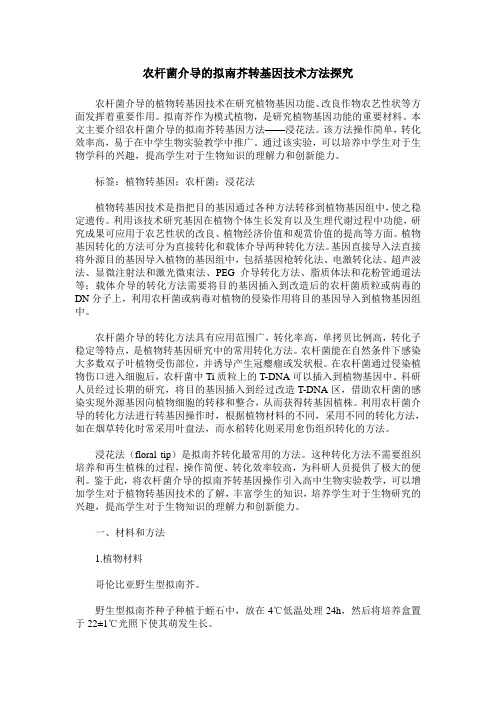
农杆菌介导的拟南芥转基因技术方法探究农杆菌介导的植物转基因技术在研究植物基因功能、改良作物农艺性状等方面发挥着重要作用。
拟南芥作为模式植物,是研究植物基因功能的重要材料。
本文主要介绍农杆菌介导的拟南芥转基因方法——浸花法。
该方法操作简单,转化效率高,易于在中学生物实验教学中推广。
通过该实验,可以培养中学生对于生物学科的兴趣,提高学生对于生物知识的理解力和创新能力。
标签:植物转基因;农杆菌;浸花法植物转基因技术是指把目的基因通过各种方法转移到植物基因组中,使之稳定遗传。
利用该技术研究基因在植物个体生长发育以及生理代谢过程中功能,研究成果可应用于农艺性状的改良、植物经济价值和观赏价值的提高等方面。
植物基因转化的方法可分为直接转化和载体介导两种转化方法。
基因直接导入法直接将外源目的基因导入植物的基因组中,包括基因枪转化法、电激转化法、超声波法、显微注射法和激光微束法、PEG 介导转化方法、脂质体法和花粉管通道法等;载体介导的转化方法需要将目的基因插入到改造后的农杆菌质粒或病毒的DN分子上,利用农杆菌或病毒对植物的侵染作用将目的基因导入到植物基因组中。
农杆菌介导的转化方法具有应用范围广,转化率高,单拷贝比例高,转化子稳定等特点,是植物转基因研究中的常用转化方法。
农杆菌能在自然条件下感染大多数双子叶植物受伤部位,并诱导产生冠瘿瘤或发状根。
在农杆菌通过侵染植物伤口进入细胞后,农杆菌中Ti质粒上的T-DNA可以插入到植物基因中。
科研人员经过长期的研究,将目的基因插入到经过改造T-DNA区,借助农杆菌的感染实现外源基因向植物细胞的转移和整合,从而获得转基因植株。
利用农杆菌介导的转化方法进行转基因操作时,根据植物材料的不同,采用不同的转化方法,如在烟草转化时常采用叶盘法,而水稻转化则采用愈伤组织转化的方法。
浸花法(floral tip)是拟南芥转化最常用的方法。
这种转化方法不需要组织培养和再生植株的过程,操作简便、转化效率较高,为科研人员提供了极大的便利。
拟南芥的遗传转化

用移液器转移到吸附柱 CP3 中,注意 尽量不要吸出沉淀。12,000 rpm 离心 30s,倒掉收集管中的废液;第六,向 吸 附 柱 CP3 中 加 入 300μl 漂 洗 液 PWT,12,000 rpm 离心 30s,倒掉收 集管中的废液;第七,重复步骤六; 第八,将吸附柱 CP3 放入收集管中, 12,000 rpm 离心 1 min,目的是将吸 附柱中残余的漂洗液去除;第九,将 吸 附 柱 CP3 置 于 一 个 干 净 的 离 心 管 中,向吸附膜的中间部位滴加 50μl 洗 脱缓冲液 TB,12,000 rpm 离心 30s 将 质粒溶液收集到离心管中。进行质粒 提取后,用两个内切酶 Bgl II 和 Pml Ι 分别对 pGM-T-目的基因的质粒和 pCAMBIA3301 载体进行双酶切。加样 结束后,混匀,37℃酶切 10h。酶切产 物进行琼脂糖凝胶电泳,且对目标片 段及 pCAMBIA3301 骨架进行胶回收。 然后,通过连接酶对目标片段和 pCAMBIA3301 骨架进行连接,构建重 组表达载体。转化大肠杆菌 Trans 5α感 受态,挑斑、摇菌,进行菌液 PCR 检 测。挑取阳性 pCAMBIA3301-目的基 因克隆提取质粒,进行双酶切验证和 测 序 。 测 序 正 确 后 , 阳 性 pCAM⁃ BIA3301-目的基因克隆质粒转化农杆 菌 EHA105 感受态。
学术探讨
XU E SHU TA N职业学院 刘晓丽 魏 楠
摘 要:通过构建重组表达载体,转化农杆菌制作浸染液,实现农杆菌介导法进行目的基因的拟南芥遗传转化,将目的基因转入到野生 型拟南芥中。通过筛选和鉴定后,得到阳性的转基因植株,最终得到纯合 T3 代转基因株系。后续可以通过对纯合转基因株系和野生型拟南 芥进行比较鉴定,即可推断目的基因在拟南芥中的功能。
拟南芥ABI5亚家族ABF1、ABF2、ABF4基因的重组及其过表达转基因拟南芥的构建
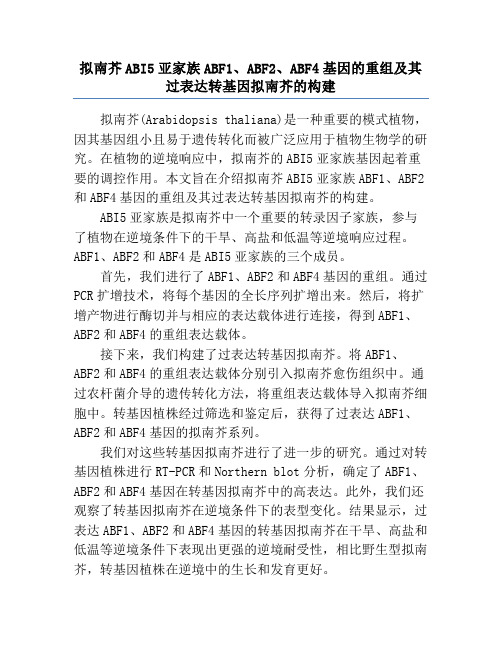
拟南芥ABI5亚家族ABF1、ABF2、ABF4基因的重组及其过表达转基因拟南芥的构建拟南芥(Arabidopsis thaliana)是一种重要的模式植物,因其基因组小且易于遗传转化而被广泛应用于植物生物学的研究。
在植物的逆境响应中,拟南芥的ABI5亚家族基因起着重要的调控作用。
本文旨在介绍拟南芥ABI5亚家族ABF1、ABF2和ABF4基因的重组及其过表达转基因拟南芥的构建。
ABI5亚家族是拟南芥中一个重要的转录因子家族,参与了植物在逆境条件下的干旱、高盐和低温等逆境响应过程。
ABF1、ABF2和ABF4是ABI5亚家族的三个成员。
首先,我们进行了ABF1、ABF2和ABF4基因的重组。
通过PCR扩增技术,将每个基因的全长序列扩增出来。
然后,将扩增产物进行酶切并与相应的表达载体进行连接,得到ABF1、ABF2和ABF4的重组表达载体。
接下来,我们构建了过表达转基因拟南芥。
将ABF1、ABF2和ABF4的重组表达载体分别引入拟南芥愈伤组织中。
通过农杆菌介导的遗传转化方法,将重组表达载体导入拟南芥细胞中。
转基因植株经过筛选和鉴定后,获得了过表达ABF1、ABF2和ABF4基因的拟南芥系列。
我们对这些转基因拟南芥进行了进一步的研究。
通过对转基因植株进行RT-PCR和Northern blot分析,确定了ABF1、ABF2和ABF4基因在转基因拟南芥中的高表达。
此外,我们还观察了转基因拟南芥在逆境条件下的表型变化。
结果显示,过表达ABF1、ABF2和ABF4基因的转基因拟南芥在干旱、高盐和低温等逆境条件下表现出更强的逆境耐受性,相比野生型拟南芥,转基因植株在逆境中的生长和发育更好。
进一步研究表明,过表达ABF1、ABF2和ABF4基因的转基因拟南芥的逆境耐受性与逆境相关基因的表达调控有关。
通过比较转基因植株和野生型植株的基因表达谱,发现转基因拟南芥中很多逆境相关基因的表达明显增加。
这表明,ABF1、ABF2和ABF4基因的过表达可能通过调控其他逆境相关基因的表达,从而增强了转基因拟南芥的逆境耐受性。
拟南芥实验用途
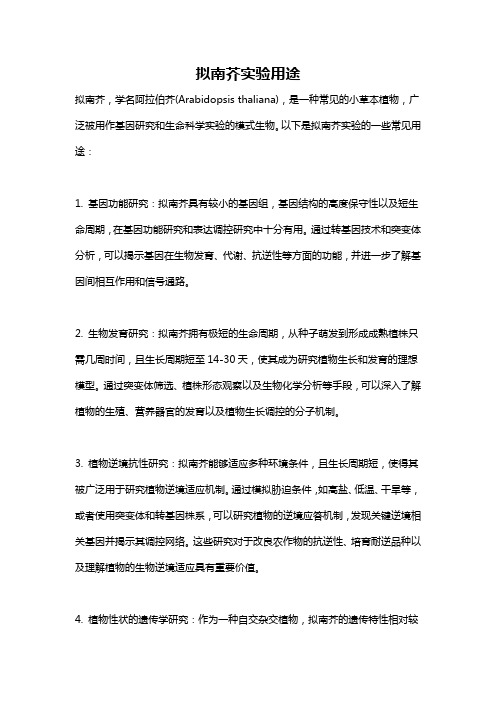
拟南芥实验用途拟南芥,学名阿拉伯芥(Arabidopsis thaliana),是一种常见的小草本植物,广泛被用作基因研究和生命科学实验的模式生物。
以下是拟南芥实验的一些常见用途:1. 基因功能研究:拟南芥具有较小的基因组,基因结构的高度保守性以及短生命周期,在基因功能研究和表达调控研究中十分有用。
通过转基因技术和突变体分析,可以揭示基因在生物发育、代谢、抗逆性等方面的功能,并进一步了解基因间相互作用和信号通路。
2. 生物发育研究:拟南芥拥有极短的生命周期,从种子萌发到形成成熟植株只需几周时间,且生长周期短至14-30天,使其成为研究植物生长和发育的理想模型。
通过突变体筛选、植株形态观察以及生物化学分析等手段,可以深入了解植物的生殖、营养器官的发育以及植物生长调控的分子机制。
3. 植物逆境抗性研究:拟南芥能够适应多种环境条件,且生长周期短,使得其被广泛用于研究植物逆境适应机制。
通过模拟胁迫条件,如高盐、低温、干旱等,或者使用突变体和转基因株系,可以研究植物的逆境应答机制,发现关键逆境相关基因并揭示其调控网络。
这些研究对于改良农作物的抗逆性、培育耐逆品种以及理解植物的生物逆境适应具有重要价值。
4. 植物性状的遗传学研究:作为一种自交杂交植物,拟南芥的遗传特性相对较为简单和容易控制。
通过制备不同基因型的杂交种子或进行人工杂交,可以研究不同基因互作对植物性状的影响。
这对于了解基因的遗传方式、基因的分离和连锁以及植物性状遗传机制具有重要意义。
5. 蛋白质互作网络研究:拟南芥基因组的序列已被完整测定,蛋白质-蛋白质互作网络逐渐建立。
通过遗传交叉分析、酵母双杂交等技术,可以筛选出与特定基因相互作用的蛋白质,从而寻找潜在的信号通路和调控网络。
这些研究有助于深入理解蛋白质相互作用及其在植物生长发育和逆境应答中的功能。
6. 转基因技术研究:拟南芥是遗传转化效率较高的模式植物之一,不仅易于基因转化,还有大量可利用的转基因工具和资源。
- 1、下载文档前请自行甄别文档内容的完整性,平台不提供额外的编辑、内容补充、找答案等附加服务。
- 2、"仅部分预览"的文档,不可在线预览部分如存在完整性等问题,可反馈申请退款(可完整预览的文档不适用该条件!)。
- 3、如文档侵犯您的权益,请联系客服反馈,我们会尽快为您处理(人工客服工作时间:9:00-18:30)。
拟南芥转基因
拟南芥是一种模式植物,多年来围绕拟南芥的相关研究很多,尤其是对于拟南芥转基因研究非常热门,相关的论文也有很多。
原因主要有以下几个方面:
1 拟南芥是一种模式植物,基因组小,克隆其基因比较简单。
2 种植方便,条件易得。
3 拟南芥是自花传粉植物,这样既很容易进行遗传分析。
4 方法简单,不同于传统的植物转基因,不需要植物组织培养阶段,对于实验操作的要求不是很高。
当前拟南芥转基因所使用的方法主要是农杆菌介导的转化(载体法),区别主要是转化的方法不同,有抽真空,花序浸染和喷雾法使用最为广泛。
农杆菌介导转化的基本流程
农杆菌(目标载体)液的制备→拟南芥种植→花期(侵染)→共培养→收种→验证
农杆菌制备
1)从—80℃冰箱中取出lml农杆菌。
2)LB培养基中添加50mg/L的卡那霉素(Kan)和100mg/L的利福平(Rif)。
3)把lml农杆菌加入到含有Kan和Rif抗生素的LB培养基中,28℃振荡10h。
4)拟南芥转基因浸润液采用的是1/2MS,加蔗糖50g/L, PH值调至5.7,。
然后在15p 压力下蒸汽灭菌15min,灭菌结束,冷却后保存于4°C,以待转基因使用。
转化
抽真空/花序浸染/喷雾法
其中抽真空法转化效率最高,但是步骤麻烦,而且要将拟南芥倒置浸染到菌液中,操作不方便。
喷雾法相比来说简便易行,而且进行重复浸染,可以提高转化效率。
验证
1.种子筛选,将收到的种子种植于含有筛选剂(卡那霉素/潮霉素等)的培养基上,筛选出抗性幼苗。
2.PCR, 提取拟南芥基因组,进行PCR扩增,核酸电泳观察有无目的基因。
